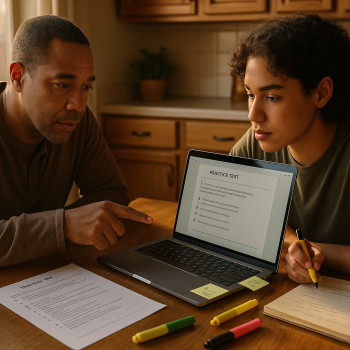Why parents matter on SAT test day
Test day is often portrayed as “all on the student,” but the reality is quieter, kinder, and more collaborative. As a parent, you are the steady hand that helps translate study-room nerves into a focused, practical routine. You can’t take the test for them, but you can shape the environment and the morning so they walk into the testing room calm, on time, and confident. This checklist gives you a practical, no-nonsense roadmap for the Digital SAT era — from admission tickets and charging cables to what to say (and not say) on the drive over.

Before test day: the essential prep parents should do
1. Confirm registration and admission details
About a week before test day, double-check the student’s registration status and admission ticket. For the Digital SAT, the Bluebook app is central — students must complete a short exam setup in Bluebook 1–5 days before the administration to generate an admission ticket. Make sure the printed or electronic admission ticket matches the student’s name exactly (no nicknames), and that the test center, date, and start time are correct.
2. Review accommodations and special instructions (if applicable)
If your student receives testing accommodations, confirm those are listed on the admission ticket. Some accommodations (like screen readers or extended time) are applied through the digital testing platform differently than on paper tests, so it’s vital to know exactly what to expect. If anything seems missing, contact the school’s SSD coordinator immediately — most accommodation requests must be handled well before test day.
3. Practice with the Bluebook interface
Familiarity reduces stress. Encourage your student to take practice digital tests in Bluebook so they’re comfortable with navigation, the built-in calculator, and universal tools like the line reader and highlighting. If your student uses assistive technology, make sure they’ve practiced with it in the digital test environment.
4. Pack essentials the night before
Create a physical checklist and pack the backpack the night before. Leaving this to the morning increases the chances of forgetfulness and tension. Below is a compact table you can print or screenshot for the night-before pack check.
| Item | Why it matters | Tip |
|---|---|---|
| Admission ticket (Bluebook-generated) | Entry to the test center and identity verification | Screenshot to phone and print a copy |
| Valid photo ID | Required for verification (school ID, driver’s license, or other accepted ID) | Confirm the name matches the admission ticket |
| Charged device and charger (if applicable) | Digital SAT uses Bluebook — ensure device is fully charged as directed | Follow test center guidance about personal devices — bring charger for pre-test setup if allowed |
| Snack and water (if allowed) | Fuel for breaks to maintain energy | Check accommodations rules for food/drink |
| Face mask/medication (if needed) | Comfort and medical needs | Bring a note from a parent for medication if required |
The morning of the test: a calm, actionable routine
1. Sleep and wake schedule
Rally for consistency, not extremes. An extra late-night cram session will not dramatically improve scores and will likely harm focus. Aim for the student’s usual sleep schedule the week leading up to the test, and the night before, prioritize 8–9 hours when possible. On test morning, wake early enough for a relaxed routine — breakfast, a bathroom break, and a quiet moment to breathe.
2. Breakfast and hydration
Choose a balanced breakfast: complex carbs, protein, and fruit. Avoid new or spicy foods that might cause stomach upset. Keep hydration steady but reasonable — the goal is focused energy, not frequent bathroom trips during the test.
3. Final document and item check
- Admission ticket (printed or on the device as instructed)
- Acceptable photo ID — verify name, expiration date, and photo
- Approved accommodations documentation (if applicable)
- Comfortable clothing layers — testing rooms can be chilly or warm
- Quiet fidget or small stress ball (if allowed under testing rules)
Drive and arrival: timing, communication, and demeanor
1. Aim to arrive early
Plan for unexpected delays — road closures, traffic, or construction — and arrive at least 30 minutes early to the test center. Early arrival reduces stress, ensures time for check-in procedures, and gives the student a buffer to use the restroom or settle in.
2. Parking, drop-off, and school policies
Know the test center’s entry point and parking rules. Some schools run SAT School Day administrations with different entry protocols; double-check any special pickup/drop-off instructions with the school ahead of time.
3. What to say on the way there
Keep conversation upbeat and practical. Avoid last-minute coaching or pressure. Instead of quizzing, try simple affirmations and a calming tone: “You’ve prepared — trust your process,” or “Focus on one question at a time.” These small phrases can shift anxiety into concentration.
During the test: support from a distance
1. Communication rules
Understand that communication during the test is restricted. Parents are typically not allowed to call or text students once the test begins. Confirm school/test center policies about communicating in emergencies, and make a pre-arranged plan for after the test.
2. Handling extended time or pick-up delays
If your student has approved extended time or other accommodations, expect them to finish later than standard testers. Plan for flexibility in your schedule — bring reading material or plan a coffee run during extended sessions instead of waiting impatiently.
After the test: debrief, rest, and next steps
1. Avoid immediate score talk
The few minutes after a test are full of emotion and half-remembered questions. Avoid asking “How do you think you did?” Instead, focus on what they need immediately: a snack, rest, or a walk. When they’re ready, have a thoughtful debrief that recognizes effort and plans the next steps.
2. Review the experience, not the answers
High-value post-test conversations center on process: What felt comfortable? Where did time feel tight? Was the Bluebook interface intuitive? Use this feedback to plan future study sessions or to inform whether to retake the test.
3. Scheduling a retake — if needed
Deciding whether to retake the SAT should be strategic. Consider how much preparation is realistic between now and the next test date, whether score-sending policies at target colleges make a difference, and whether specific content areas need targeted improvement. If your student plans to retake, create a focused plan: target score, practice schedule, and areas to improve.
Practical checklist table: quick reference for parents
| When | Action | Who |
|---|---|---|
| 1–2 weeks before | Confirm registration, check Bluebook setup, verify accommodations | Parent + Student |
| Night before | Pack admission ticket, photo ID, charger, snack, layers; set alarm | Student (with parent checklist) |
| Morning of | Healthy breakfast, final item check, leave early for test center | Parent + Student |
| After test | Provide emotional support, debrief process, plan next steps | Parent + Student |
Special situations parents should prepare for
1. If your student is testing with accommodations
Accommodations must be approved in advance by Services for Students with Disabilities (SSD). Some accommodations are delivered differently on digital tests — for example, a human reader might be replaced by a screen reader or other assistive technology. If your student has accommodations, give extra time to practice with the specific setup they’ll use on test day and confirm that their admission ticket shows the approved accommodations.
2. If the student feels sick
If your student is mildly unwell, consult the test center’s policies — many centers allow testing with mild illness, but severe symptoms may require rescheduling. Keep their wellbeing and the health of others in mind; if in doubt, rescheduling is often the sensible choice.
3. If something goes wrong at check-in
Stay calm and patient. Common issues include mismatched names on ID and admission ticket or an unprinted admission ticket. Have identification and proof of registration ready on your phone. If problems can’t be resolved on-site, ask the test center proctor for clear next steps — they can contact the College Board if needed.
How parents can support the broader prep — beyond test day
1. Encourage structured, balanced practice
Regular, deliberate practice beats random cramming. Help your student set a realistic study schedule with focused practice on weak areas. Use full-length timed sections occasionally to build stamina and familiarity with the testing rhythm.
2. Consider targeted, personalized support
When study plateaus or anxiety is high, targeted tutoring can make a big difference. Sparkl’s personalized tutoring approach — 1-on-1 guidance, tailored study plans, expert tutors, and AI-driven insights — can help students identify high-impact weaknesses and track progress efficiently. Personalized coaching often provides structure, accountability, and techniques that general practice alone doesn’t deliver.
3. Keep perspective
SAT scores are one part of a broader college application — grades, essays, recommendations, and extracurriculars matter too. Reinforce the message that while SAT performance is important, it’s not the sole measure of potential.

What parents should avoid saying or doing on test day
- Don’t quiz or review content on the way to the test — it increases anxiety and clouds focus.
- Avoid statements that promise that this one test will define everything. Pressure can translate into performance issues.
- Don’t compare scores or testing experiences with other students; each student’s journey is unique.
Final tips: small habits that make a big difference
- Practice the morning routine a few times before test day (alarm, breakfast, commute) to identify friction points.
- Create a simple “Post-Test Plan” — a relaxing activity or small celebration so your student has something to look forward to after the exam.
- Keep a log of time-management during practice tests so you can spot patterns and adjust pacing strategies.
- If anxiety is a major factor, explore breathing techniques or short mindfulness practices the student can use before the test starts.
Wrapping up: your role as a calm, practical ally
On test day, your composure matters. A calm parent helps a nervous student focus on what they can control: arriving prepared, executing a familiar routine, and pacing themselves through the sections. Use the checklists above, plan logistics early, and prioritize rest and focus over last-minute cramming. If targeted help makes sense, consider personalized tutoring options like Sparkl’s tailored plans and expert guidance to build confidence before the next test date.
At its best, the SAT is a single snapshot among many in your student’s application. Your role is to make sure that snapshot is as clear and relaxed as possible — through preparation, presence, and practical support. You’ve got this, and so does your student.
Quick printable checklist (one-line version): Admission ticket, photo ID, practice with Bluebook, accommodations confirmed, charged device (if applicable), snack, layered clothing, arrive early, calm support after the test.
Helpful reminders and next steps
After test day, give your student time to decompress. When they’re ready, review their experience, identify two areas to improve (one content area, one timing/strategy area), and create a small practice plan for the next 4–6 weeks. If you need a structured, personalized approach to the next steps, consider working with a professional tutoring service that offers one-on-one coaching and tailored study plans to convert insights into higher scores.
Best of luck to your student — clear planning, steady reassurance, and a calm presence go a long way toward making SAT test day a positive, manageable milestone.













No Comments
Leave a comment Cancel